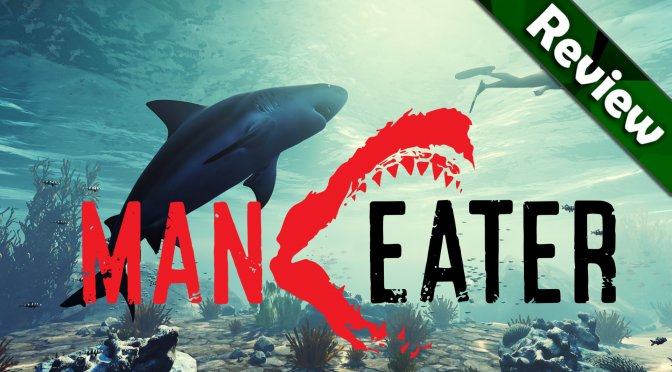I’ve been looking forward to Maneater since it’s initial announcement in 2018. There aren’t many modern shark games around, certainly none that are open world RPGs, so it peaked my interest.
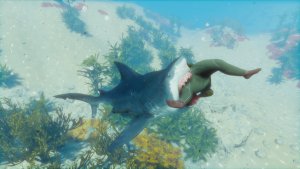
Maneater is developed by Tripwire, the team that brought us Killing Floor and Killing Floor 2, both of which were multiplayer games. Thus, Maneater is the studio’s first venture into a single player, open world RPG. It gets many things right for sure, but unfortunately there are several areas where it misses the mark and as a direct result makes you feel like you’re playing in the shallows rather than the deep blue sea.
The story itself is told in the way of a documentary with a narrator which, for the most part, works well. I’m not going to talk too much about the story itself as I don’t want to spoil anything, but it’s essentially a tale of revenge between a famous shark hunter by the name of Scaly Pete and your bloodline.
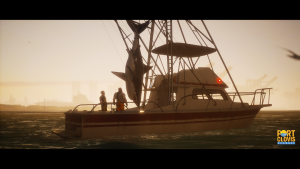
Outside of the cutscenes the narrator (Chris Parnell) is commenting on pretty much everything you do. So when you eat something, find collectibles, die, fight hunters, or defeat bosses he has something to say. There are a ton of references and throwbacks which is a nice touch.
Eventually the comments over your normal gameplay will start to repeat themselves, and as a result may outstay their welcome after a hew hours. I would’ve liked to have seen the option to disable generic commentary and keep the once-off commentary when finding landmarks, killing bosses and other special events in the game.
Maneater starts you off as an adult mother shark for the tutorial, during which it guides you through the basic controls and systems present in the game. After you have completed this section, you’ll take control of a female shark pup and begin your journey to become a megalodon over the course of the short campaign.
You’ll be doing a lot of eating in this game. Eating things gives you XP which is required to level up, which increases your size. At certain levels you’ll change from pup to teen, to adult, to elder and finally to megalodon. At each of these stages your stats and abilities increase. In addition to gaining XP, eating also gives you resources like proteins, minerals, fat, and if you find an albino animal, a rare resource called mutagen x, which are all required to upgrade your sharks various evolutions and perks when they are unlocked.
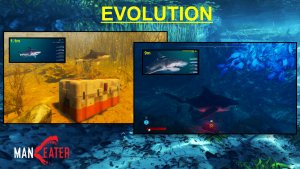
Finding collectibles in each zone give you bonus resources. Finding all the landmarks in a zone will unlock a shadow evolution/perk, killing an apex predator in a zone will unlock a bone evolution/perk, and defeating hunter bosses will unlock an bio-electric evolution/perks respectively. I say evolution/perk because depending on what zone or boss you complete determines what you’ll get. In order to get all the evolutions/perks of each type, you will need to finish these tasks in all of the 8 zones in the game.
There are five parts that you can upgrade on your shark. These are the tail, body, fin, head and teeth. Having a fully equipped set gives you a set bonus, but you can also mix and match sets depending on your playstyle. Each evolution can be upgraded, making it more effective, and each part cosmetically changes the look of your shark. Unfortunately, mixing and matching evolutions makes your shark look very mismatched. I do wish that there were more purely cosmetic customization options for your shark, despite what evolutions were chosen.
The Bone evolution deals with damage mitigation and resistance, Shadow evolution deals with poison and debuffs, and the Bio-electric evolution deals with stuns and crowd control for the most part. In addition, each part also increases various stats for the shark.
Each body evolution grants an ability that can be used once the meter fills up (according to your overall kills). Bone grants damage resistance, damage reduction and ram damage, Shadow grants slows down everything around you for a short time, and increases your speed, and Bio-Electric grants you a lighting aura that shocks anything near you.
However, in practice, I found a mostly bone build to be the best by far, and ended up using it for pretty much the entire playthrough. I would’ve liked to have seen a better implementation and usefulness to these evolutions.
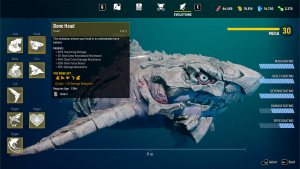
In addition to the evolutions that are unlocked, you can also unlock new perks, and can equip up to 3 at any one time. They range from improving your sonar ability, increasing swim speed, adding more health, or breathing longer on land for example. There are a total of 11 of perks available.
Each zone has a grotto, which once unlocked, acts as a place to respawn if you die, upgrade your shark when you hit the various level stages, switch out perks/evolutions to change your current build, and a place to fast travel on the map (unless you’re in combat). These build changes can be done at any time and do not cost any resources.
Combat is not overly complicated. You have an attack, a tail whip, and a dodge. Each aggressive sea creature has a different pattern and has a vulnerable window. If you attack while the creatures are vulnerable, you do more damage. Moreover, and if it’s the same size or smaller than you, you’ll have the opportunity to thrash it as well doing additional damage. Unfortunately, most aggressive enemy encounters play out the the same way, and that includes even the apex predators (the boss fight in each zone).
I would’ve liked to have seen the need to employ different tactics with different enemies, but as it stands, and regardless of the enemy, it boils down to waiting for them to attack, then dodging, biting a few times, thrash them if possible, rinse and repeat.
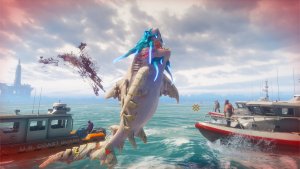
The combat against hunters is slightly different. Depending on your level of infamy, hunters will use different weapons. They will use spear guns, shotguns, assault rifles, and eventually bombs. You’ll be jumping out of the water to grab hunters off the boats, killing scuba divers or ramming the boats to destroy them, during which you’ll be dodging the ranged telegraphed hunter attacks. Rinse and repeat, until you unlock the boss or need to disengage to get some health (as long as you’re engaged, the hunters will keep re-spawning around you).
The tail whip is quite useful early on in the game. You can grab any prey smaller and hit it towards your target for some damage. In practice, tail whipping turtles was best since it stuns the target and puts it in a vulnerable state. Doing it with anything else was not worth it due to the low damage.
While the combat is repetitive, there is something inherently enjoyable about eating everything and watching your shark grow, evolve and become the top of the food chain. The animations are fluid as are the controls, which give a sense of weight and momentum to the movements and combat. This helps to create a feeling of immersion in the world. Also causing chaos on the beaches and amongst the swimmers remains entertaining, at least for a while.
The one big issue I have with combat is the inability to hard lock a target, so that the camera stays focused on it. There is a soft lock, so when you get close enough a marker appears so you know who you have targeted, and there is a also a key to focus the camera on your target. My biggest gripe is that – in combat – all the predators lunge past you when attacking, so you are constantly forced to turn around, and refocus on them with the focus camera key or your camera controls. The focus camera key is also a bit problematic. While it focuses on aggressive targets, it will not always focus on the target you want, which can lead to some unwieldy situations when being attacked by multiple enemies. The game also lacks a hard lock toggle for the focus key. I’m not sure why they chose to do it this way, however, it seems like an odd design choice.
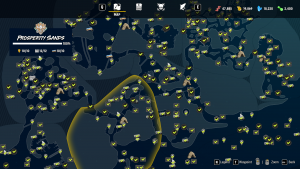
Exploration in the game is enjoyable. Thankfully, each zone is varied aesthetically. There are different fish species in each biome, there is a day/night cycle (unfortunately no weather effects), and the wildlife don’t attack each other which makes the world feel a little static in some ways. Overall though, the game is graphically competent, with great sound design, making for a believable underwater adventure.
I took my time and explored almost everywhere I could and so by the time I got to the last few zones, I had more than enough resources to upgrade every single evolution and perk in the game… and still had extra resources. The downside of this was that it removed any incentive to go after any remaining collectibles that only offered resources.
The main issue I have with the Maneater is that it just lacks variety. There are 8 zones in the game, that increase in difficulty, but you do exactly the same thing in every single one. Nothing changes. Find the grotto. Eat 10 of these fish, eat 10 of those fish and keep doing these missions until a bar fills up. Then the apex predator appears, kill it, get the evolution, move to the next zone and do exactly the same thing all over again.
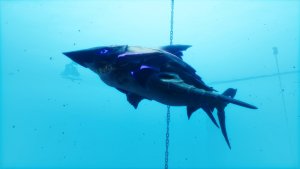
There are side missions as well. These require you to kill humans for resources and XP rewards, and at the same time gradually increase your infamy as you move from zone to zone. When the infamy bar is full, hunters arrive to hunt you. Killing enough of them will summon the hunter boss. Killing these bosses will reward you with a new bio-electric evolution/perk, depending on which boss it is. So there is an incentive to draw these guys out, but the caveat that as your infamy increases the hunting parties get harder and more numerous.
The problem is, as with fighting sea creatures, fighting humans plays out exactly the same each time. Ram the boat, or jump out and grab the hunters off the boat. Kill divers and dodge projectiles. Fiull yup the bar until the hunter boss arrives, kill him and start working toward the next one. Rinse and repeat. Also every single boss is basically the same as normal hunter, no special mechanics. Jump out the water, grab them off the boat and you win.
Some of the story missions are of course a little more interesting since they are specially designed encounters, but there aren’t very many of them, and they are still not groundbreaking.
In addition to the repetitiveness of the game, it’s also incredibly easy, has no difficult settings to adjust, or a new game + mode, so there is no way to start a harder playthrough with all the evolutions unlocked.
The developers have said if you want to make it harder for yourself, you can choose to not use evolutions and take on larger enemies. While this is certainly one solution, having an actual difficulty setting would’ve been far better in my opinion.
The game is also pretty short. I finished it at nearly 100% in about 11 hours, and that was with a lot of extra exploring. If I’d skipped trying to get collectibles and made a beeline through story, it could probably be done in less than 8 hours. Although, if the game had lasted longer, perhaps the repetitiveness would’ve been an even greater issue.
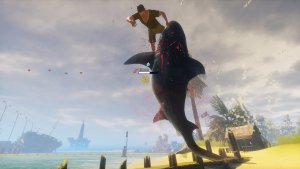
On the technical side I didn’t come across any game breaking bugs, which was a surprise based on the state of many releases these days. However there were notable optimization issues present. I have a fairly beefy rig and there were numerous instances were the frame rate dropped below 40-50, (with an i7 6700k @ 4.5gh , a RTX 2070 Super @1080p, and running the game on an SSD). Changing details settings did not fix it. Some of drops seem to be related to loading assets, but other times it seems connected to how much is going on.
There was a patch over the weekend that supposedly addressed some of these performance issues, but in my testing while finishing up this review I’ve not noticed any improvement. To be fair, it was not enough to ruin the experience, but it’s certainly an issue that will need more work going forward. The game also “supports” Nvidia Ansel, but it’s hit and miss. More than half the time it just doesn’t work and requires restarting the game.
All in all I think Maneater, while not perfect, was certainly enjoyable. In fact I’ve considered starting a second playthrough (after taking a break of course). Yes it is repetitive and lacks variety, and it’s not particularly deep as far as combat goes, but there just aren’t many other games that will offer this experience, and the moment to moment gameplay loop is enjoyable.
I don’t know what the developers’ plans are for the game going forward, but it has potential. Whether they are planning DLC or a sequel, I’m looking forward to see what comes next. I want to conclude by saying that I think the asking price is a little high for what’s on offer here, so I can’t recommend it at full price. Still, it’s worth picking up on sale if you are looking for something different to sink your teeth into.
![]()
- An open world shark RPG
- You get to be a Megalodon
- Seeing the shark evolve & grow is awesome
- Unique premise and setting
- The game looks nice
- You get to eat everything in sight.
![]()
- Repetitive
- Not much variety
- Short campaign
- Shallow gameplay
- Evolutions could’ve been deeper
- Very easy/No difficulty settings or New game+
- Optimization Issues
Playtime: 11 hours total. Stephen completed the campaign.
Computer Specs: Windows 10 64-bit computer using an Intel i7-6700k CPU@4.5gh, 32GB Ram, and an nVidia RTX 2070 Super graphics card.
Stephen is our resident kung fu master and reviewer. When he’s not kung fu fighting, he’s playing games, and has been since the atari 2600. He also runs his own YouTube channel called Particular Pixels, where he creates a variety of content related to PC gaming. He goes by the nickname Shaoling (not to be confused with Shaolin), which comes from his favorite PC game of all time, System Shock 2.

